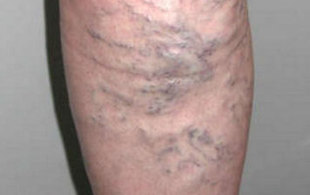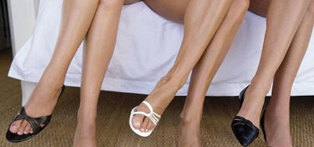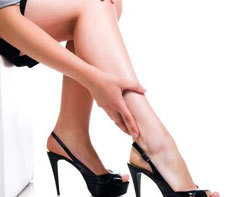Diseases with a "broad geography", which is diagnosed in more than half of the population of the country – the varices of the lower extremities.
Large varicose veins is caused by the large disturbances in the system of the outflow of venous blood in the foot area, or drains, and vascular clogged, provoking the development of degradation processes in the inflammation of vascular walls. This process contributes to the failure of the valve system and connective tissue weakness of the veins.

What is the "root of evil"?
A huge extensive system of reservoirs, including superficial and deep vein blood vessels, the blood supply of the heart of man. Unites them among themselves a sort of alarm system, ensuring the timely discharge of blood.
The main burden in ensuring the circulation falls on the deep venous vessels, due to their volume and strength. And just a small dose of a burden they take on each other is a superficial blood vessels.
The heart as a pump "running" the blood of the vascular channels. Under certain load conditions (a person's walk, squat, etc.) of the heart for her to incorporate in her veins, overcomes the gravitational force (gravity). When the muscle tissue of the foot relaxed (in the weak natrenirovannosti or at rest), under the weight of gravity the blood, rapidly goes down to the feet.
The availability on the walls of veins to specific places contributes to filling valve function and prevents reverse circulation of the blood. Values of the valve system is very large, it plays the role of a trigger and any damage leads to disruption of blood flow and increased blood flow, released down.
It causes stagnation of blood in the veins, their enlargement and inflammatory processes, swelling and bumps, the failure of the valve system is not able to stop the dilated veins. The result – a violation of blood circulation in the extremities and varicose vein expansion.
The causes of varicose veins
The disease has two forms of development – primary and secondary. The formation of primary varicose of the legs is caused by pathologies of the inflammation of the walls:
- a reduction in their tension;
- the loss of elasticity;
- the increased intravenous pressure;
- nodular bodies in the expanded blood vessels.
In the development of these diseases is not the last role to play:
- genetic predisposition;
- advanced age;
- overweight and injury;
- large load on the leg veins.
Trigger the development of disease may be sudden load on the legs and trouble of pregnancy and childbirth. The consequence of these factors, in most cases, the state increased intravenous pressure in the extremities and damage to the valve apparatus.
The reason the secondary forms of – post-thrombotic varicose caused by pathological processes in the vascular system of the legs in the shape of:
- thrombosis, delegated in the primary stage of the disease;
- congenital vascular dysplasia and fistulas in the arteries and the veins;
- syndrome Parkes-Weber;
- tumors and injuries of the;
- immunological and neuroendocrine disorders.

Another factor in the development of varicose veins in women can be hormonal birth control, which causes hormonal imbalance. Direct dependence has not been confirmed, but as a result of their ingestion may develop complicated processes of pre-existing pathology, resulting varicose veins of the extremities.
The initial symptoms of varicose veins on the legs that are non-specific and few. Very significant for varicose veins, pain syndrome in the legs on exertion, accompanied by hill and burning of the affected parts.
A common phenomenon – fatigue the legs, swelling of the rear zone of the feet and ankles. Appears a painful whine character, walking on the road by inflammation of the blood vessels.
A common symptom of the initial stage of the disease is that the pain and swelling significant, stronger in the evening and the morning are held. Visible changes lived at the beginning of the disease is not observed. The patient may experience, just more fatigue.
- Progresses the disease slowly, may develop over the years. Lack of timely treatment may manifest chronic venous insufficiency.
Symptoms of varicose veins of the legs - 7 signs
The main symptoms of varicose veins on the leg are characterized by:
1. External changes in the blood vessels. Modified the shape and configuration of the deep and subcutaneous blood vessels – the most striking symptom of varicose veins. Celebrate the saccular, and either a uniform focal thickening of the blood vessels with the nodular formations and the localization of the club.
They are purple or cyanotic color. Previously visible small blood vessels show through on the surface as small the vascular network. Often these changes are manifested on the tibia and on the inside of the heel area.
2. The pain syndrome. The usual is his speech – caviar. With the development of the disease, they become stronger and are accompanied by muscle spasms of the lower extremities, orthostatic disease – leaving the head in the supine position and restore when moving to a standing position.
Painful palpation in the absence of visible changes, confirms the fact that the pathological changes in deep-lying vessels.
3. Swelling. The manifestation of edema of the legs in the process of the formation of varicose veins – a characteristic symptomatology. Manifests localization in the lower third of the lower leg and stop. In this case, in the projection of the lesion creates a strong itching of the skin.
If during a night's rest swelling it subsides, this is an alarming signal, indicating the final stage of progression of the disease (degree of decompensation). In such a situation it is necessary to exclude the entry of infection and don't miss the development of venous leg ulcers.
4. Itchy skin, manifested in the development of clear signs of varicose veins, when it has already incurred as referred diseases of the venous outflow.
5. Hyperpigmentation, emerging on the background of pronounced clinical symptoms. The skin in the zone of damaged veins, on their roads and in the vicinity, in places of bruises and injuries, is subjected to induration (seal), become dark and blue, leads to thinning of the surface epithelium and atrophy of the subcutaneous structures.
6. Flushing – the feeling of continuous cycles of freezing limbs, fingers and soles of the feet.
7. The development of open venous ulcers – it is considered a complicated choice varicose veins, and either a result of certain changes in the areas of the skin at the last stage of the disease.
For different people, and the disease proceeds differently, according to individual peculiarities of the arrangement of the inflammation of the blood vessels (surface or deep).
Therefore, the most dangerous of the "underwater stone" varicose veins, it is the smallest, asymptomatic period, which can manifest itself right now running stage.
Which doctor-specialist you contact?

At the onset and the initial symptoms of the disease, it is necessary to immediately seek medical help. After all, in the early stage, the disease can even stop the medical therapy. Treatment of varicose veins on the legs deals with a specific doctor.
If such a specialist in an ambulance is not, the problem may decide that the name of the appropriate treatment.
Treatment of varicose veins on the legs
Treatment of varicose veins on the legs is constructed according to the degree of vascular.
- The first phase is due to the manifestation of the syndrome of fatigue in the legs accompanied by swelling.
- The second phase dates back pathology with the constant edema, pigmentation of the skin with the seal of the subcutaneous structures (fiber), and the development of various chimneys.
- The third phase is characterized by ulcerative defects of trophic genesis.
Of course, to stop the process easier, without having to wait for the third stage of the disease. In the early stages to stop the process you can still medical therapy, supplement is for the effectiveness of home remedies.
There are various treatment options for varicose veins on the legs in the early stages of the disease. These include medical therapy or various procedures minimally invasive technology.
Firstly, it is the compression garments (stockings, tights, socks) and elastic bandaging. When squeezing certain muscle groups, leads to improved blood flow and reduction of the processes of stagnation of blood. This technique eliminates the further expansion of blood vessels and the development of thrombosis.
To date, the perfect medical remedies from varicose veins, which would affect all aspects of the pathogenetic process in the development of disease – no. In most cases, apply special therapy. Partly to stop the process of development in the initial stages of the conservative therapy is possible, but are already available traffic nodes education medicines cannot be deleted.
Drugs for the treatment of varicose veins of the legs
1. Basic receiving drugs that can restore vascular tone, release of venous stasis and improve the processes of microcirculation in the tissues – in the form of sprays, gels, powders and ointments.
2. To prevent the development of thrombosis prescribed medications with the incorporation of heparin, perfectly thinning the blood.
3. For the reduction of inflammatory processes, swelling, and numbness, most often they are special gels, sprays and ointments from varicose veins.
Operative intervention
Neglected during the process of varicose veins on the legs, the operation can not be avoided. Modern methods of minimally invasive and is fundamentally different from the old methods. Characterized by low trauma and the lack of a clear head. It:
- minimally invasive technique procedures, eliminating the pathology of the venous return;
- multiple modification procedures, selected with regard to the currents of the pathology;
- the technique of sclerosing, based on the solution of blood flow by the method of clustering of inflammation of the vascular walls;
- the closure of the inflammation of the spaces laser coagulation;
- treatment of varicose veins of the great vessels by the method of radiofrequency ablation;
- and the combined technique of sclerosing and other procedures.
Treatment method is designed with regard to clinical images. It is therefore very important to seek medical help in a timely manner. No need to hope, that the effectiveness of the various methods of home treatment.
They are only capable of reducing the severity of symptomatology, but to completely cure is not possible. The most effective means, the operation of complement to medical therapy include:

- compresses, tinctures and warming wraps from fruit kernels, green bark, leaves and cauliflower plants – well-known for its healing properties, of horse chestnut;
- compresses and rubbing the affected veins apple cider vinegar;
- aids and compresses of tincture of sour with wormwood;
- socks, trays and equipment on the blue clay;
- drinking grape juice or wine from red varieties of grapes.
And certainly not to anyone not harm, recommended and selected by your doctor special exercises physical therapy.
Prevention of varicose veins
As a preventive measure applied:
- pouring of the feet with a gradual decrease in temperature, for the improvement of blood circulation;
- foot baths with subsequent friction of the towel and the application of a treatment cream;
- massage;
- during the game your legs in the raised position.
Recommendation: refrain from visiting the hot steam baths, saunas and spas, to rule out physical load on the legs. Balance nutritious diet and give up smoking and alcohol. Remove the extra weight and pick up the comfortable shoes.




































